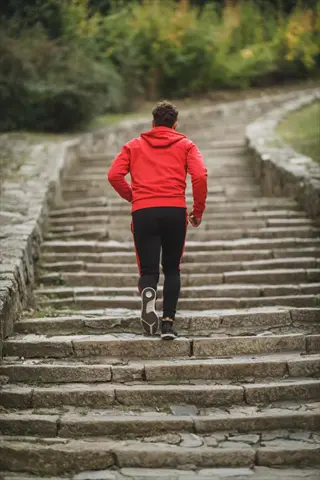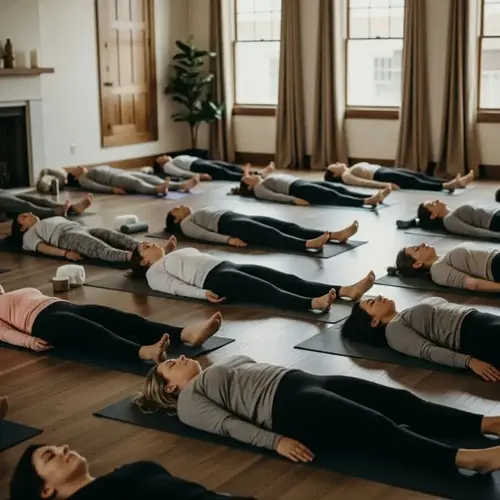10 Aerobic Exercise Advantages Backed by Science

Written by
Gina Mason
Reviewed by
Prof. Benjamin Murphy, Ph.D.The benefits of aerobic exercise consist of improvements in heart health, weight control, and blood sugar control.
Regular exercise will strengthen your cardiovascular health, reducing risk of disease by 20-30%.
Aerobic exercise has great impacts on mental health, significantly reducing anxiety and depressive symptoms.
Your immune system will improve and can result in reducing your illness by 30-40% through the cellular enhancement of aerobic exercise.
Weight-bearing aerobic exercise can promote bone density increase of 1-3% per year.
Walking is accessible for everyone of all ages, and does not require any special equipment.
Article Navigation
Grasping the benefits of aerobic exercise starts with understanding what aerobic exercise means. It is a type of rhythmic activity performed with oxygen to energize the body. Think of things like walking, swimming, and cycling. These types of activities strengthen the heart muscle over time. Also, the lungs work better. This translates to tangible health benefits that you can experience.
The World Health Organization reveals a disturbing fact. Almost one in four adults worldwide is insufficiently active. This inactivity leads to many health problems that can be avoided. Initiating aerobic exercise habits can halt this trend. Simple movements can cause significant improvements in global wellness imaging.
The foundation of aerobic fitness is, in fact, cardiovascular efficiency. A commonly accepted fact about aerobic fitness: Regular programs build stronger pumps that in turn supply the body with better blood flow in the arteries and veins and oxygen to the muscles, which effectively reduces disease and increases energy.
No special gear or fitness center memberships are necessary for participation. Walking in the neighborhood costs nothing. The type of bicycle used for pedal power is the common variety employed by many people. These are excellent introductory activities for improving health. This was the means by which I started my journey toward fitness a few years ago.
Safe Exercise Practices
If you have existing joint pain or heart problems, consult your physician before starting an aerobic regimen. This safeguard can save you from injury. I say this from experience since there was a time several years ago when I forced myself to continue through pain in my knees. On that occasion, a professional trainer would have been in a position to suggest just what I should do to work safely through my condition.
During exercise, use the talk test to help you understand how hard your workout is. You should be able to carry on a comfortable conversation using full sentences instead of gasping for breath. For example, recite a nursery rhyme or describe your plans for dinner. If you can't talk comfortably, slow down immediately.
Always start with 5-10 minutes of warm-up exercises. Most often, I do arm circles or gentle marching. In the end, be sure to do cool-down stretches while holding each position for a few seconds. Whether or not you're going to work out, this prepares the body and prevents strains. I never skip this part, even for short workouts.
Opt for low-impact alternatives if you are sensitive in your joints. Swimming facilitates body weight support, relieving stress on the knees. Cycling has a smooth motion and will not cause pounding. Both are fantastic for cardiovascular exercise while protecting vulnerable joints.
Pre-Work Checklist
- Consult healthcare providers before starting new routines if you have chronic joint pain or heart conditions
- Use the talk test method: speak full sentences comfortably during exercise to monitor intensity levels
- Check equipment stability and wear proper footwear to prevent slips and falls during workouts
- Hydrate with 8-10 oz (237-296 ml) of water 30 minutes before beginning exercise sessions
- Verify ambient temperature stays between 68-72°F (20-22°C) for optimal workout conditions
- Perform light dynamic stretches like leg swings or arm circles to prepare muscles
Injury Prevention Strategies
- Perform 5-10 minute warm-up and cool-down periods to gradually increase heart rate and circulation
- Choose low-impact alternatives like swimming instead of running to reduce joint stress impact
- Stop immediately if experiencing chest pressure, dizziness or sharp pain during physical activity
- Build intensity gradually: increase duration by 10% weekly to prevent overuse injuries
- Use compression sleeves on knees or elbows if you have arthritis during high-impact activities
- Maintain proper form: keep spine neutral and knees aligned over toes during squats
Hydration Guidelines
- Drink 17-20 oz (500-600 ml) of water 2 hours before exercise to ensure optimal hydration levels
- During workouts lasting over 60 minutes, consume 7-10 oz (200-300 ml) every 10-20 minutes
- After exercise, replace fluids by drinking 16-24 oz (470-710 ml) per pound of body weight lost
- Monitor urine color: pale yellow indicates proper hydration while dark yellow signals dehydration
- For intense sessions exceeding 90 minutes, include electrolytes like sodium and potassium
- Avoid caffeine and alcohol which can cause fluid loss exceeding 3% of body weight
Footwear Selection
- Choose shoes designed for your specific activity: running shoes for jogging, cross-trainers for gym
- Ensure adequate arch support and cushioning to reduce impact on knees and hips by 40%
- Replace athletic shoes every 300-500 miles (480-800 km) or when tread wear becomes uneven
- Wear moisture-wicking socks to prevent blisters and maintain foot temperature around 75°F (24°C)
- Get professionally fitted: allow 0.5 inch (1.3 cm) space between longest toe and shoe end
- Consider orthotics if you have flat feet or high arches to correct biomechanical issues
Environmental Safety
- Avoid outdoor exercise when air quality index exceeds 100 or ozone levels are high
- In hot weather above 85°F (29°C), exercise during cooler morning or evening hours
- In cold below 32°F (0°C), wear layered clothing and protect extremities from frostbite
- Use sunscreen with SPF 30+ when exercising outdoors for more than 15 minutes
- Stay visible at night with reflective gear and lights during early morning/late evening workouts
- Monitor humidity levels: above 70% humidity impairs sweat evaporation and cooling
Getting Started Guide
Begin your aerobic activity with a simple walk. To start, it is best to walk a couple of 5-minute sections every day at a walking pace of 2.5mph or 4 km/h, focusing on consistency rather than speed. This is how I started twenty years ago. The body is easily overwhelmed, so take time to build up its defenses.
Achieve intermediate fitness levels through a weekly increase in duration. After two weeks of exercise, increase the duration to ten minutes at three mph (or 4.8 km/h). Add gentle increases in grade by way of hills or a treadmill. This method will ensure a gradual increase in endurance without undue strain being placed on beings.
Take advantage of zero-cost options before resorting to equipment. Walking needs supportive shoes only. Stair climbing could utilize existing structures. Dance aerobics requires a little space. These free activities can bring the full benefit. I still prefer walking outdoors to using machines in the gym.
You should continually monitor your heart rate to ensure you are training at the correct intensity. To figure out your maximum heart rate, subtract your age from 220. Beginners should aim for 50 - 60% of their maximum heart rate. This is a safe and effective workout intensity. I check my heart rate by taking my pulse during cool-downs.

Brisk Walking
- Effectiveness: Achieve calorie expenditure between 240-300 calories per hour maintaining a consistent 3.5 mph (5.6 km/h) walking pace outdoors
- Terrain Tips: Initiate routines on flat even surfaces before progressively introducing hills or stairs for controlled difficulty advancement
- Form Focus: Maintain upright posture alignment with arms swinging naturally at 90-degree angles to optimize energy efficiency during movement
- Schedule: Schedule sessions during early morning or evening hours to obtain beneficial vitamin D absorption when sunlight exposure permits
- Progression: Systematically increase walking speed by approximately 0.5 mph monthly to ensure continual cardiovascular adaptation and improvement
- Safety: Utilize reflective clothing elements during low-light conditions to maximize visibility and prevent potential pedestrian accidents

Stair Climbing
- Calorie Burn: Expend significant energy estimated between 400-500 calories hourly when climbing standard stair flights at moderate continuous pace
- Technique: Execute full foot placement on each step while utilizing handrails minimally for balance maintenance rather than weight support
- Beginner Approach: Commence with manageable sets of 2-3 flight ascents allowing 60-second recovery intervals between each climbing segment
- Posture: Maintain slight forward torso lean with abdominal core engaged throughout movements to protect spinal integrity during ascents
- Locations: Access public infrastructure stairwells including libraries, stadiums or apartment buildings for convenient cost-free training environments
- Progression: Increase climbing volume systematically adding one additional flight weekly until achieving ten continuous flight capabilities

Dance Aerobics
- Music Selection: Choose musical tracks maintaining 120-140 beats per minute tempos to establish optimal movement pacing for cardiovascular stimulation
- Space Needs: Clear approximately 6x6 feet (1.8x1.8 meters) of indoor or outdoor area ensuring unobstructed movement safety during routines
- Beginner Moves: Initiate with fundamental steps including side-to-side touches, alternating knee lifts and uncomplicated grapevine patterns
- Duration: Begin with achievable 10-minute movement segments progressively extending to 30-minute continuous dance-based aerobic sessions
- Online Resources: Access complimentary beginner tutorial content through reputable YouTube fitness channels for structured guidance
- Calorie Estimate: Anticipate energy expenditure ranging from 250-400 calories hourly depending on movement intensity and individual body metrics

Park Bench Step-Ups
- Equipment Alternative: Utilize sturdy public park benches as practical platforms for stepping exercises requiring no financial investment
- Technique: Execute controlled stepping motions alternating lead legs while maintaining upright posture throughout each repetition sequence
- Beginner Protocol: Complete three sets of ten step-ups per leg allowing adequate recovery between sets to prevent premature fatigue
- Intensity: Sustain cardiovascular intensity within 65-75% maximum heart rate parameters throughout the stepping exercise duration
- Safety Check: Verify bench heights remain at or below knee-level to ensure appropriate biomechanical positioning during stepping motions
- Progression: Increase repetition volume incrementally adding five additional reps weekly until reaching thirty repetitions per leg

Jump Rope
- Calorie Burn: Achieve high metabolic demand expending 600-800 calories hourly when executing continuous moderate-intensity rope jumping sequences
- Beginner Modifications: Practice movement patterns initially without ropes to establish proper jumping mechanics before adding equipment
- Surface Choice: Select forgiving surfaces like grassy areas or rubber mats to minimize joint impact forces during repetitive jumping motions
- Footwear: Utilize well-cushioned athletic shoes specifically designed for impact absorption to protect lower extremity joints
- Interval Approach: Implement structured training alternating thirty seconds jumping intervals with ninety seconds active recovery periods
- Progression: Extend jumping durations incrementally adding five seconds weekly to systematically build cardiovascular endurance capacity

Hill Sprints
- Location Selection: Identify moderate inclines in neighborhood parks or natural settings avoiding excessively steep gradients initially
- Technique: Employ compact stride patterns with forward torso inclination to optimize biomechanical efficiency during uphill running efforts
- Beginner Protocol: Execute 4-5 short sprint bursts lasting approximately ten seconds each with complete recovery between efforts
- Recovery: Utilize controlled walking descents between sprint repetitions to facilitate adequate cardiorespiratory recovery before subsequent efforts
- Safety: Avoid incline gradients exceeding 20% during initial training phases to prevent excessive musculoskeletal strain and potential injury
- Progression: Incorporate additional sprint repetitions weekly building systematically toward ten repetitions as fitness levels improve

Lunges
- Form Focus: Maintain precise knee alignment directly above ankle joints throughout descent phases to prevent undue ligament stress
- Space Requirement: Clear minimal floor space measuring approximately 4x4 feet (1.2x1.2 meters) for safe lunge execution
- Beginner Approach: Initiate with stationary lunges before progressing to more complex walking or reverse lunge movement variations
- Repetitions: Complete three sets of eight repetitions per leg initially focusing on movement quality rather than speed
- Balance Aid: Lightly contact walls or stable furniture if needed during initial learning phases to maintain postural stability
- Progression: Increase repetition volume systematically adding two repetitions weekly until achieving twenty per leg capabilities

Swimming
- Location Options: Access public aquatic environments including guarded beaches, lakes or community pool facilities when available
- Stroke Selection: Prioritize beginner-friendly strokes like freestyle or breaststroke before advancing to more technically complex variations
- Duration: Commence with manageable ten-minute continuous swimming intervals before extending duration as aquatic endurance improves
- Safety: Strictly avoid solo swimming sessions utilizing only lifeguarded areas or supervised swimming environments for security
- Calorie Burn: Expend substantial energy estimated between 400-500 calories hourly when swimming moderate-intensity freestyle laps
- Progression: Increase swimming distance systematically adding twenty-five yards (approximately 23 meters) weekly to endurance capabilities

Hiking
- Trail Selection: Begin with paved or well-maintained paths before advancing to natural surface trails with moderate technical challenges
- Pace Target: Maintain consistent hiking speeds between 2.5-3 mph (4-4.8 km/h) when carrying lightweight hydration backpacks
- Footwear: Select specialized trail shoes featuring ankle support structures and aggressive tread patterns for optimal trail surface traction
- Hydration: Transport adequate hydration supplies estimating twenty ounces (591 ml) per hiking hour in moderate temperature conditions
- Elevation Gain: Initiate with trails featuring cumulative elevation gains below five hundred feet (152 meters) for manageable intensity
- Progression: Increase hiking distances incrementally adding half-mile (0.8 km) segments weekly to systematically build endurance capabilities

Shadow Boxing
- Space Needs: Clear approximately 5x5 feet (1.5x1.5 meters) of indoor area ensuring sufficient clearance for unencumbered movement
- Stance: Maintain athletic positioning with knees comfortably flexed and weight evenly distributed between both lower extremities
- Combinations: Initiate with fundamental punch sequences like jab-cross combinations before integrating hooks or uppercut variations
- Duration: Complete multiple three-minute rounds separated by one-minute active recovery periods to simulate boxing training structures
- Footwork: Incorporate lateral shuffling and pivoting movements to enhance cardiovascular demand beyond stationary punching sequences
- Calorie Burn: Achieve metabolic expenditure between 350-450 calories hourly during moderate-intensity shadow boxing training sessions
Week 1: Foundation Building
- Begin with two daily 5-minute walking sessions maintaining a steady 2.5 mph (4 km/h) pace to safely establish routine consistency without strain
- Calculate and maintain 50-60% of your maximum heart rate using the formula (220 minus age) multiplied by 0.5 for optimal beginner intensity levels
- Incorporate 3-minute dynamic stretching sequences including arm circles and leg swings to properly prepare muscles before each aerobic activity session
- Record daily step counts through smartphone tracking apps aiming for an achievable initial goal between 3,000 and 5,000 steps per day
- Hydrate effectively by consuming 8 oz (237 ml) of water approximately 30 minutes before starting and after completing each workout session
- Focus primarily on consistency rather than speed or distance ensuring completion of at least 10 sessions weekly for foundational habit development
Week 2-3: Duration Increase
- Gradually extend walking sessions to 10 minutes twice daily while increasing pace to 3 mph (4.8 km/h) to moderately challenge endurance capabilities
- Progressively raise workout intensity to reach 60% of your maximum heart rate over this two-week period while monitoring exertion carefully
- Introduce incline variations such as 3-5% treadmill grades or natural hilly terrain to enhance cardiovascular demand during walking sessions
- Elevate daily step goals to 5,000-7,000 steps using reliable activity trackers to objectively measure incremental fitness improvements
- Add post-workout static stretching routines holding positions like quad stretches for 30 seconds to maintain flexibility and reduce soreness
- Monitor exertion levels continuously ensuring conversation remains comfortable throughout activities indicating appropriate aerobic intensity maintenance
Week 4-6: Intensity Development
- Advance to 15-minute continuous sessions at 3.5 mph (5.6 km/h) pace to significantly improve cardiovascular endurance during this phase
- Achieve 65-70% of maximum heart rate during peak workout segments to safely elevate aerobic capacity without overexertion risks
- Incorporate bodyweight exercises including squats and lunges during cool-down periods to build complementary strength alongside cardiovascular fitness
- Reach daily step targets between 7,000 and 10,000 steps using fitness trackers to objectively measure progressive distance coverage improvements
- Add light resistance elements such as carrying 2-5 lb (0.9-2.3 kg) hand weights during walks to increase metabolic demand gradually
- Implement interval training structures alternating 1 minute brisk pace segments with 2 minutes recovery periods for enhanced calorie expenditure
Week 7-9: Consistency Mastery
- Extend sessions to 20 minutes of continuous aerobic activity maintaining a 4 mph (6.4 km/h) pace to develop endurance sustainability
- Maintain 70-75% maximum heart rate throughout workouts to optimize cardiovascular improvement while ensuring breathing remains controlled
- Introduce varied terrain experiences including sand, grass or nature trails to challenge balance and engage different muscle groups simultaneously
- Track measurable progress by recording weekly distance coverage statistics to provide concrete motivation through visible achievement milestones
- Hydrate strategically during exercise consuming approximately 7 oz (207 ml) of water every 20 minutes to maintain optimal fluid balance
- Establish consistent timing routines exercising at the same time daily to reinforce habit formation through neurological patterning mechanisms
Week 10-12: Endurance Building
- Complete 30-minute aerobic sessions maintaining 4.5 mph (7.2 km/h) pace to achieve substantial cardiovascular endurance development targets
- Reach 75-80% maximum heart rate during workout peaks to safely maximize aerobic capacity improvements through controlled intensity progression
- Add stair climbing elements completing at least 5 flights daily to develop leg strength synergistically with cardiovascular conditioning
- Monitor resting heart rate trends which should decrease by 5-10 beats per minute monthly indicating improving cardiovascular efficiency
- Incorporate cross-training variations alternating between walking and cycling activities to prevent plateaus through workout diversity implementation
- Achieve consistent daily step counts exceeding 12,000 steps to maintain comprehensive fitness levels through habitual activity integration
Aerobic vs Anaerobic Comparison
Aerobic activity is an activity that requires a continuous intake of oxygen for fuel for extended periods of time. Oxygen breaks down glucose and fats for activities like running. Anaerobic work requires stored energy with no oxygen to exert energy for short bursts. Think sprinting or heavy weight lifting. Due to the difference in oxygen intake, the body's response is altered.
The energy systems are starkly different. Aerobic work primarily uses your aerobic metabolism system, which includes using your mitochondria. Anaerobic work utilizes rapid fuel systems, such as ATP and glycogen. Your muscles throughout the body depend on different burning characteristics based on the demand for work. I feel it most through my legs and how they respond to the varying needs of the workout.
Duration and intensity clearly distinguish these exercise forms. For one, aerobic workouts last longer than 15 minutes and occur at a heart rate between 60% and 80% of the maximum heart rate. That's 120-160 beats per minute for many. Anaerobic workouts involve bursts of 80 to 100% of the maximum heart rate in short bursts of less than 2 minutes. The most accurate and practical method of determining exercise intensity is using a heart rate monitor.
Employ dual measurements for clarity. The speed might be 5 miles per hour, 8 kilometers per hour. The heart rate ranges also apply equally. This helps everyone keep a more accurate watch on their effort. I instruct my clients in both systems, as outlined in the training schedules we follow.
Aerobic Programming
- Perform sessions lasting 30-60 minutes maintaining 60-80% maximum heart rate intensity levels
- Schedule workouts 3-5 times weekly with at least one rest day between intense sessions
- Progress gradually increasing duration by 10% weekly before increasing speed or incline
- Monitor exertion using talk test: should maintain conversation capability throughout
- Include variety: alternate between running, cycling and swimming activities weekly
- Allow 24-48 hours recovery between sessions for optimal cardiovascular adaptation
Anaerobic Programming
- Execute short bursts lasting 10-120 seconds at 80-100% maximum heart rate intensity
- Limit sessions to 2-3 times weekly allowing 48-72 hours muscle recovery periods
- Structure interval training: 30 seconds sprinting followed by 90 seconds walking
- Prioritize proper form over speed to prevent injury during high-intensity movements
- Combine with strength training: perform after aerobic sessions when fatigued
- Hydrate with electrolyte-enhanced beverages replacing sodium lost through sweat
Hybrid Approach
- Combine both types: perform aerobic base training before anaerobic intervals
- Sample structure: 20 minutes jogging followed by 5 sprint intervals
- Monitor recovery: resting heart rate should decrease by 5 bpm monthly
- Periodize training: focus 8-12 weeks aerobic before anaerobic phases
- Ensure calorie intake matches expenditure: add 300-500 calories on training days
- Track progress: aerobic via distance times, anaerobic via power output
Contraindications
- Avoid anaerobic training with uncontrolled hypertension or heart conditions
- Modify aerobic intensity for arthritis sufferers using swimming alternatives
- Consult physicians before starting anaerobic programs if diabetic
- Reduce impact activities during pregnancy: replace running with cycling
- Monitor joint pain: cease activity if sharp discomfort persists
- Adjust for climate: indoor alternatives when AQI exceeds 100
Progress Tracking
- Aerobic: Measure resting heart rate decrease and distance covered monthly
- Anaerobic: Track power output improvements and recovery speed
- Use wearable technology monitoring heart rate variability trends
- Record perceived exertion scores after each session (1-10 scale)
- Conduct fitness tests quarterly: 1.5 mile run and vertical jump
- Adjust programs when progress plateaus exceed 3 consecutive weeks
10 Aerobic Exercise Advantages
The advantages of aerobic exercises begin with heart conditioning through the delivery of oxygen during exercise. The heart muscle becomes more efficient at pumping blood. This decreases the resting heart rate by 5-10 beats per minute. This also significantly reduces the risk of cardiovascular disease. I have seen clients who have shown improvement in a month's time.
Increased insulin sensitivity allows better blood sugar regulation. The cells have a greater ability to take glucose during and after exercise. You can expect an average fasting blood sugar drop of 10-15 mg/ dL. This equals 0.5-0.8 mmol/L. You will experience more consistent energy throughout the day. This is what I found helped me through the afternoon relative lows.
Mental health experiences a major lift through the release of endorphins. Symptoms of anxiety frequently begin to lessen within twenty minutes of the beginning of the activity. Regular treatments may cut depression scores by almost fifty percent. Additionally, the quality of sleep has also improved. These improvements change daily life at any age.
Bone density increases by 1 to 3% per year with weight-bearing activities, such as walking. Immunity is strengthened through better circulation in the cells. Improved bone density, plus everyone benefits from the added activities they can perform, which require no equipment. I have successfully worked with clients ranging from 12 to 85 years old.
Heart Strengthening
- Regular aerobic exercise conditions the heart muscle to pump blood more efficiently reducing resting heart rate by 5-10 beats per minute within months
- Improved cardiac output delivers oxygen-rich blood more effectively to muscles and organs throughout the entire body during physical activity
- The left ventricle adapts by enlarging slightly allowing greater blood volume ejection with each contraction improving circulation efficiency
- Cardiovascular disease risk decreases by 20-30% as arterial plaque buildup slows due to improved blood flow dynamics
- Resting blood pressure typically lowers by 5-7 mmHg systolic and 3-5 mmHg diastolic measurements after consistent training
- Heart rate recovery after exercise improves significantly indicating enhanced cardiovascular fitness and autonomic nervous system function
Blood Pressure Control
- Sustained aerobic activity enhances arterial flexibility and reduces vascular resistance helping decrease systolic pressure by 5-7 mmHg consistently
- This natural regulation mechanism supports healthy blood flow without medication dependency for many individuals with pre-hypertension conditions
- Blood vessel endothelial function improves through increased nitric oxide production which helps dilate arteries naturally
- The renin-angiotensin hormone system becomes better regulated reducing fluid retention and associated pressure elevations
- Even moderate activities like brisk walking can lower hypertension risk by 25-30% when performed most days weekly
- Combined with dietary sodium reduction these effects provide comprehensive blood pressure management solutions
Blood Sugar Regulation
- Aerobic exercise increases insulin sensitivity allowing cells to absorb glucose more efficiently reducing fasting blood sugar by 10-15 mg/dL (0.5-0.8 mmol/L)
- Daily 30-minute sessions help maintain stable energy levels preventing energy crashes common with blood sugar fluctuations throughout the day
- Muscle contractions during exercise activate glucose transporters independent of insulin providing alternative sugar uptake pathways
- Liver glycogen storage capacity increases reducing excessive glucose circulation between meals and overnight periods
- Post-meal blood sugar spikes decrease by 20-30% when walking occurs within 60 minutes after eating carbohydrate-rich foods
- Long-term HbA1c levels typically decrease by 0.5-1.0 percentage points indicating better three-month glucose control
Weight Management
- Moderate aerobic activities like brisk walking burn 240-300 calories hourly creating consistent energy deficits for sustainable fat loss over time
- Combined with balanced nutrition this helps reduce body fat percentage while preserving valuable lean muscle mass effectively
- Excess post-exercise oxygen consumption increases metabolism for several hours after activity completion adding extra calorie burn
- Visceral abdominal fat decreases preferentially with regular aerobic training reducing waist circumference measurements significantly
- Appetite hormones like leptin and ghrelin become better regulated reducing cravings and supporting portion control efforts
- Metabolic rate elevation continues during rest periods as muscle mitochondrial density increases improving energy utilization efficiency
Mental Health Boost
- Endorphin release during aerobic exercise alleviates stress hormones lowering anxiety symptoms within 20 minutes of activity initiation
- Regular participants report 30-50% reduction in depression scale scores demonstrating mood enhancement comparable to therapy results
- Brain-derived neurotrophic factor increases promoting neuron growth particularly in memory centers like the hippocampus region
- Cognitive function improves with better focus attention and information processing speeds during mentally demanding tasks
- Sleep quality enhances significantly with aerobic exercisers falling asleep faster and experiencing deeper restorative sleep cycles
- Self-esteem and body image perceptions improve substantially contributing to overall psychological well-being improvements
Immune System Support
- Moderate aerobic activity increases circulation of immune cells like neutrophils and immunoglobulins reducing common cold incidence by 30-40%
- This protective effect peaks with 30-60 minute sessions avoiding excessive duration that may temporarily suppress immunity function
- Antibody response to vaccinations improves with regular exercisers developing stronger protective immunity after immunization
- Lymphatic system circulation enhances helping remove toxins and waste products more efficiently from bodily tissues
- Inflammation markers like C-reactive protein decrease significantly with consistent moderate-intensity aerobic training
- Immune cell surveillance against abnormal cell development improves potentially reducing certain cancer risks
Bone Density Improvement
- Weight-bearing aerobic exercises like walking stimulate osteoblast activity increasing bone mineral density by 1-3% annually in adults
- This reduces fracture risk significantly especially in postmenopausal women vulnerable to osteoporosis development concerns
- Bone remodeling rates increase with mechanical loading creating stronger trabecular bone architecture throughout the skeleton
- Impact forces during activities signal bones to deposit more calcium and mineral content strengthening structural integrity
- Joint cartilage receives better nutrition through improved synovial fluid circulation reducing osteoarthritis progression risks
- Postural stability and balance improvements reduce fall likelihood which is particularly important for elderly individuals
Enhanced Lung Capacity
- Deeper breathing patterns during aerobic exercise strengthen respiratory muscles improving oxygen uptake efficiency by 15-25% over six months
- Expanded lung volume allows better oxygenation during daily activities reducing breathlessness during routine physical tasks
- Alveolar surface area available for gas exchange increases improving oxygen-carbon dioxide transfer efficiency significantly
- Respiratory muscle endurance improves allowing longer activity durations before experiencing breathing fatigue limitations
- Bronchial tube dilation enhances during exercise reducing airway resistance and asthmatic symptom severity for many individuals
- Ventilation-perfusion matching improves ensuring optimal oxygen delivery to the most active muscle groups during exertion
Longevity Promotion
- Consistent aerobic exercisers add 3-5 years to lifespan through reduced inflammation and improved cellular repair mechanisms
- Studies show 40% lower all-cause mortality in adults completing 150+ weekly minutes of moderate-intensity physical activity
- Telomere length preservation slows cellular aging processes reducing biological age compared to chronological age measurements
- Mitochondrial biogenesis increases providing more cellular energy factories that improve overall metabolic health substantially
- Chronic disease risks decrease including cardiovascular conditions diabetes and certain cancers contributing to extended healthspan
- Cognitive decline rates slow significantly with active seniors maintaining better memory and executive function capabilities
Accessibility & Affordability
- Effective aerobic options require zero financial investment with walking costing nothing beyond supportive footwear requirements
- These activities accommodate all fitness levels through adjustable intensity making health benefits universally achievable regardless of status
- Minimal equipment needs allow exercise in diverse environments from urban sidewalks to rural pathways without gym dependencies
- Time-efficient protocols like high-intensity interval training provide maximum benefits in as little as 20-minute sessions weekly
- Social aspects enhance adherence with group walking clubs or community-based activity programs fostering supportive relationships
- Adaptability for disabilities includes chair aerobics water exercises and recumbent cycling options ensuring inclusive participation
5 Common Myths
The general belief that aerobic exercise produce considerable fat loss in the absence of dietary change is erroneous and misleading
While aerobic exercise consume fat reserves, an accompaniing reduction of fat reserves by nutritional modification is largely necessary, as frequently sufficient amounts of fat reserves are not destroyed, due to an excessive intake of calories by foods that are strongly fattening. A 30-minute trot may consume 300 calories, but a single sweetmeat between meals may cause the previous increase to be made with no further exercise. For the continued reduction in fat reserves, improved health and increased energy, an exercise program, along with correct dietary habits, are of equal importance and are synergistically active in their value.
Many mistakenly believe that sweating heavily during workouts means that good fat burning is occurring
Sweating is primarily a mechanism of body temperature regulation through evaporative cooling, and has nothing to do with metabolization of fat. Humidity, genetic considerations and hydration levels are more responsible for the amount of sweating than the number of calories burned. Fat loss results from regular calorie deficits over time, regardless of the amount of sweating There can be extensive fat loss without sweating, and it is a dangerous faulty premise to consider sweating as meaning loss of fat while working out. This faulty approach leads to dangers of dehydration by different malaise instigating methods while working out.
The false assumption that aerobic exercise benefits only young people ignores its universal health benefits.
Aerobic exercise has health benefits throughout life, including increased mobility, cognitive function and chronic disease management for older people. Lower impact forms of the exercise, such as swimming and cycling, allow for the joint limitations often found in the older population yet still provide improvement to cardiovascular function. Many studies have proven that physical activity will reduce the risk of falling in older people by as much as 30 percent. In addition, it has been shown that keeping physically active longer results in greater longevity and independence than a sedentary lifestyle.
Assuming that longer workout durations produce better fitness results does not take biological recovery needs into account
Going over 60-90 minutes of moderate aerobic activity can promote the release of cortisol which, in this case, can lead to a counterproductive catabolism of muscle tissue. The best results come from finding a good balance of consistent workouts of say 30-45 minutes at the appropriate intensities rather than wasting time on marathon workouts. The body must be given sufficient time of recovery, and overtraining more often than not leads to injury, immune disorders, and performance plateaus rather than a continued improvement in fitness.
This false concept that quality aerobic workouts require expensive gym equipment keeps many from beginning
Quality aerobic workouts do not require any specialized equipment, but you can go out walking, climbing stairs or dancing, for example. All these activities give the benefits of aerobic exercise to the heart and circulation. Outdoor places, such as parks, are free for use, and exercises with the bodyweight, such as push-ups, pull-ups, dips, etc., require no money at all. Machines offer a convenience, but research shows that exercise such as walking, practiced outdoors produces the same health improvements as working out on a treadmill in a fitness center.
Conclusion
The Benefits of Aerobic Exercise Improve Health In Many Ways Aerobic exercise strengthens your heart, allowing it to pump blood more efficiently. Your mind feels clearer, and you feel less anxious. Your body is capable of regulating sugar and weight more effectively. All of these benefits work together to contribute to powerful and lasting improvements in your overall wellness.
You don't need any special gear or expenses to start. Walking outdoors costs nothing but time. Using stairs utilizes structures already built around you. I began using park benches for step-ups. These accessible options will work for every level of fitness and all ages.
Act immediately with this simple first step. Take a five-minute walk today around your home. Check your pulse with your fingers to track your rate. Tomorrow repeat extending to seven minutes. At this stage, it is better to engage in regular and consistent exercises rather than more strenuous ones.
The road to better health begins today. These 10 benefits become a reality with regular practice, and I have seen clients transform their lives in a matter of months. Their energy soars while they reduce their health risks. The ability to begin is within you today.
External Sources
Frequently Asked Questions
What are the primary advantages of aerobic exercise?
Key aerobic exercise advantages include improved cardiovascular health, better blood sugar control, effective weight management, and enhanced mental well-being. Regular sessions also strengthen immunity, increase bone density, and promote longevity through cellular health improvements.
Is daily aerobic exercise recommended?
Moderate aerobic activity can be done daily, but balance is crucial:
- Low-intensity activities like walking are safe for daily practice
- High-intensity sessions require 48-hour recovery periods
- Alternate muscle groups to prevent overuse injuries
- Listen to your body's signals for adequate rest needs
How does aerobic exercise benefit mental health?
Aerobic activity triggers endorphin release that reduces stress hormones within minutes. Regular participants experience significant anxiety and depression symptom reduction, improved sleep quality, and enhanced cognitive function through increased brain-derived neurotrophic factor production.
Can aerobic exercise help with weight loss?
Yes, aerobic exercise creates calorie deficits crucial for weight management:
- Burns substantial calories during sessions
- Elevates metabolism for hours afterward
- Reduces visceral abdominal fat effectively
- Should be combined with balanced nutrition
What's the difference between aerobic and anaerobic exercise?
Aerobic exercise uses oxygen for sustained energy production during longer activities, while anaerobic relies on glucose breakdown for short bursts. Aerobic improves cardiovascular endurance, whereas anaerobic builds power and strength through high-intensity efforts.
Is walking considered effective aerobic exercise?
Walking qualifies as excellent low-impact aerobic exercise that improves cardiovascular health. When performed briskly for sufficient duration, it delivers comparable benefits to more intense activities while being accessible to all fitness levels.
How quickly do aerobic fitness improvements occur?
Noticeable aerobic fitness gains typically emerge within weeks:
- Resting heart rate decreases in 3-4 weeks
- Endurance improvements appear within a month
- Blood pressure reductions manifest in 6-8 weeks
- Maximum benefits accumulate over consistent months
What are common aerobic exercise mistakes?
Frequent errors include skipping warm-ups, progressing too rapidly, maintaining poor form, and ignoring hydration needs. Beginners often overestimate required intensity while underestimating consistency's importance for sustainable results.
Can seniors benefit from aerobic exercise?
Absolutely. Aerobic activity helps seniors maintain mobility, cognitive function, and independence. Low-impact options like swimming or cycling accommodate joint limitations while reducing fall risk and managing chronic conditions effectively.
Does aerobic exercise require special equipment?
No equipment is necessary for effective aerobic workouts. Numerous zero-cost options exist:
- Walking requires only supportive shoes
- Stair climbing uses existing structures
- Dance aerobics needs minimal space
- Bodyweight exercises require no investment

